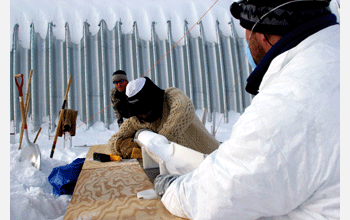Multimedia Gallery
West Antarctic Ice Sheet drilling
Scientist Joe Souney of the University of New Hampshire bags an ice core at the West Antarctic Ice Sheet Divide field camp, where he and a small research team drilled two ice cores during the Antarctic summer of 2006. The ice core will be taken back to the United States for study.
More about this image
The West Antarctic Ice Sheet (WAIS) Divide deep ice-coring project is funded by the National Science Foundation (NSF) and is the second component to the larger WAISCORES initiative. WAIS Divide will collect a deep ice core from the flow divide in central West Antarctica in order to develop a unique series of interrelated climate, ice dynamics and biologic records focused on understanding interactions among global Earth systems.
The WAIS Divide ice core will provide Antarctic records on environmental change with the highest possible time resolution for the last ~100,000 years, and will be the Southern Hemisphere equivalent of the Greenland GISP2, GRIP and North GRIP ice cores.
The most significant and unique characteristic of the project will be the development of climate records with an absolute, annual-layer-counted chronology for the most recent ~40,000 years. In addition, due to the high snowfall rate, the WAIS Divide record will have only a small offset between the age of the ice and the air trapped in the ice.
The WAIS Divide ice core will enable detailed comparison of environmental conditions between the Northern and Southern hemispheres, and the study of greenhouse gas concentrations in the paleo-atmosphere, with a greater level of detail than previously possible.
Read more about Joe Souney's ice-coring research trip to the ice in The Antarctic Sun story "The core of WAIS Divide field camp" in the Jan. 7, 2007, edition. Or, learn more about the WAIS Divide program on the WAIS website. (Date of Image: Dec. 6, 2006)
Credit: Photo by Steven Profaizer, NSF
Images and other media in the National Science Foundation Multimedia Gallery are available for use in print and electronic material by NSF employees, members of the media, university staff, teachers and the general public. All media in the gallery are intended for personal, educational and nonprofit/non-commercial use only.
Images credited to the National Science Foundation, a federal agency, are in the public domain. The images were created by employees of the United States Government as part of their official duties or prepared by contractors as "works for hire" for NSF. You may freely use NSF-credited images and, at your discretion, credit NSF with a "Courtesy: National Science Foundation" notation.
Additional information about general usage can be found in Conditions.
Also Available:
Download the high-resolution JPG version of the image. (4.2 MB)
Use your mouse to right-click (Mac users may need to Ctrl-click) the link above and choose the option that will save the file or target to your computer.

